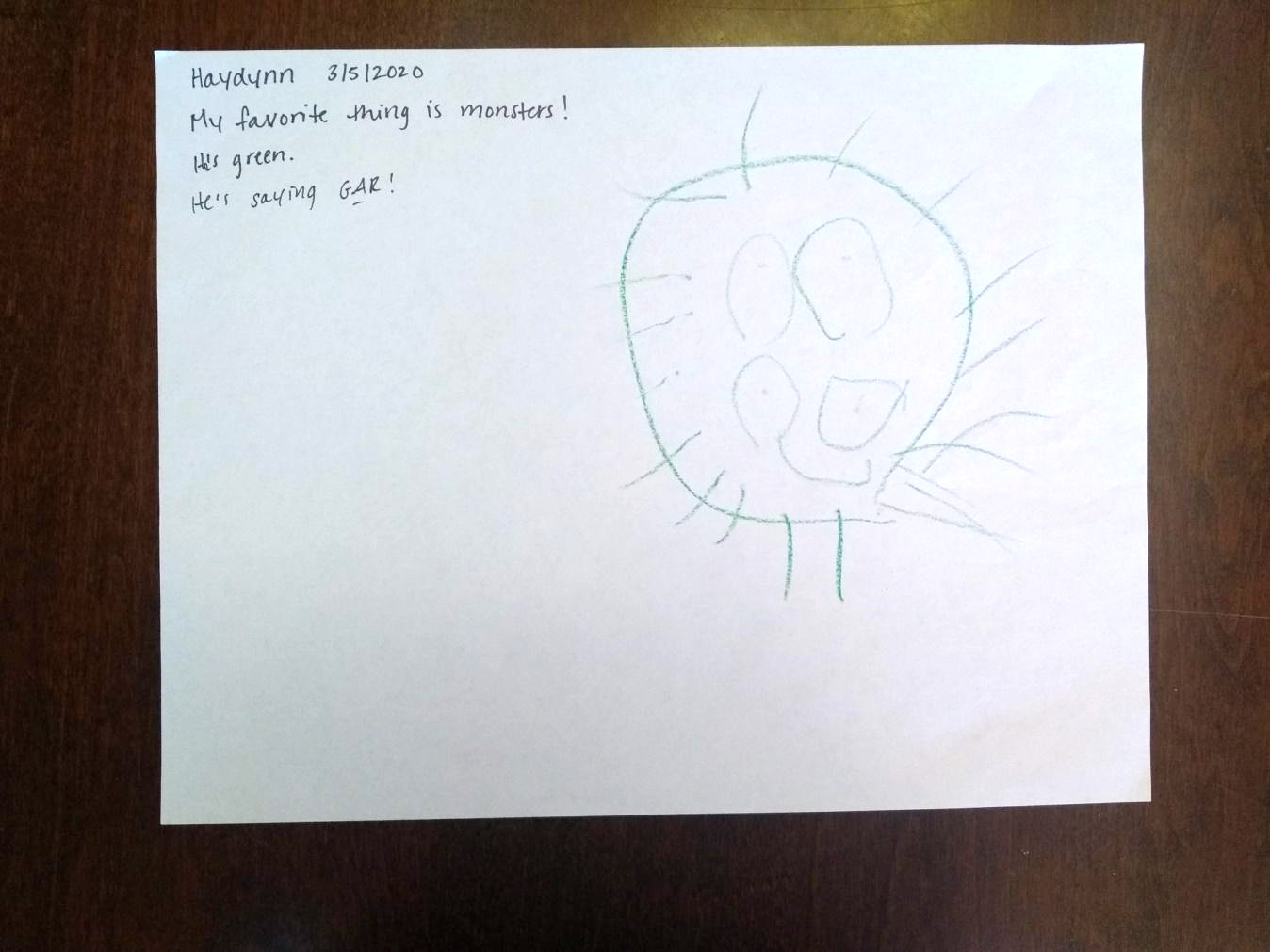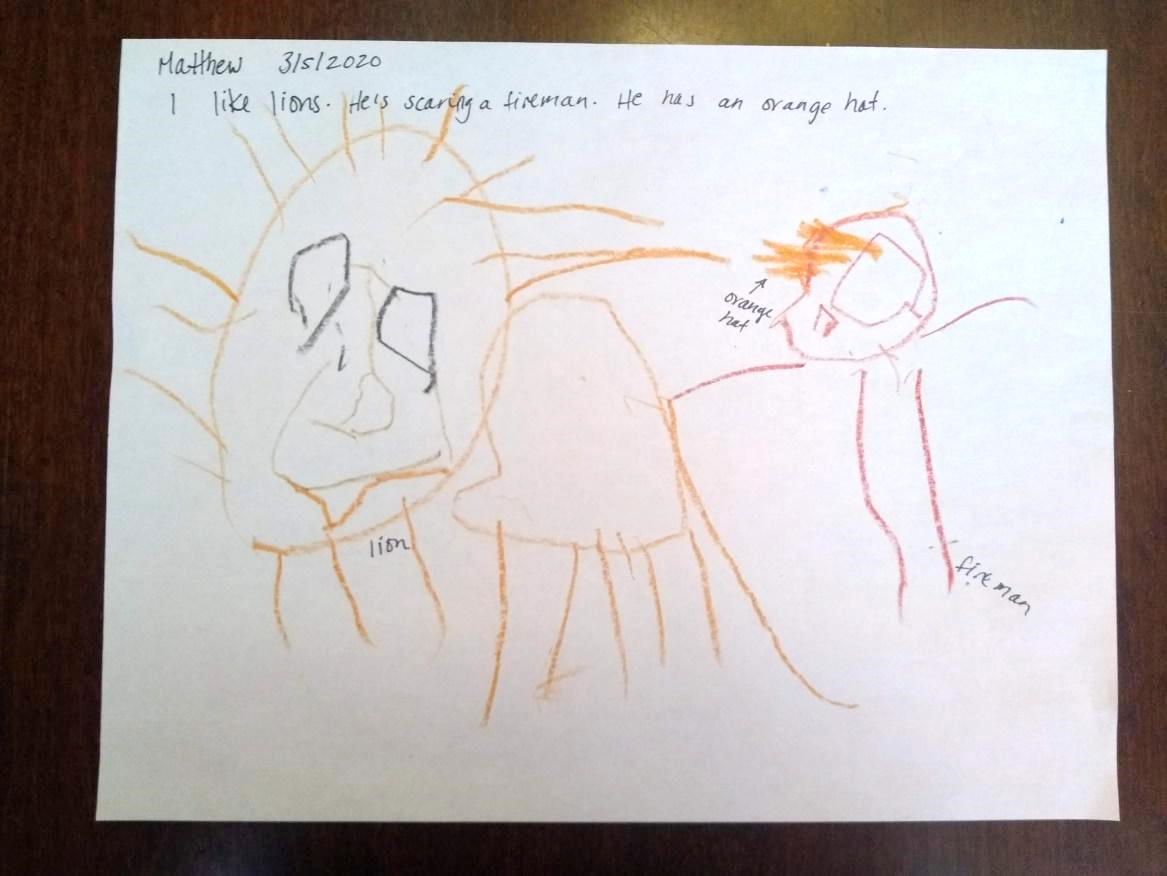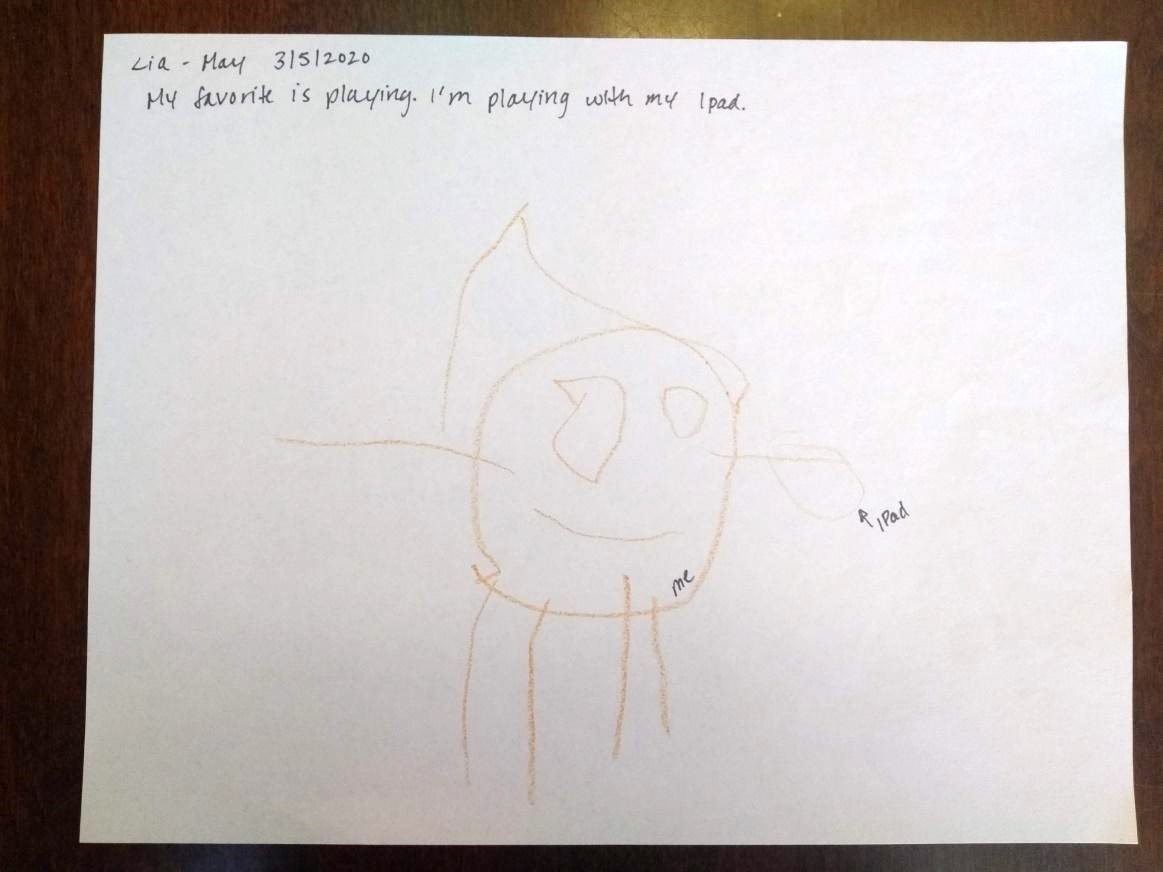Preschoolers Write Their First Stories through Art
Cassandra Sutherland
My co-teacher Elizabeth Stokes and I were both first year teachers who co-taught a class of children ages 2–4 at Creation School. I had been a stay-at-home mom for eight years with an engineering degree and Elizabeth had just received a bachelor’s degree in physiology and molecular and cellular biology. The only experience I had with young children was raising three of my own and teaching a week of Vacation Bible School. As for teaching, I had tutored college students throughout life as a job or a hobby. Miss Elizabeth had babysitting and Vacation Bible School nursery experience. We were mentored in teaching young children by the experienced, excellent Creation School preschool teachers.
My classroom consisted of five girls and four boys. Children were mostly of European American background. We had twin boys who were adopted and a girl from South Africa who spoke her native language. Our preschool is located in Vail, Arizona, 24 miles southeast of Tucson in Pima County in the heart of the Sonoran Desert.
I started the Global Literacy Community to satisfy a requirement for continued learning per my teaching contract. I never realized that it would inspire me the way it did. I didn’t know anything about global literature before this. We began by reading Exploring International and Intercultural Understanding Through Global Literature (Corapi & Short, 2015) and “Engaging Young Children With Global Literature” (Acevedo, Pangle, Kleker, & Short, 2017) which helped me understand the importance of global literature in developing children’s understandings and appreciations of others in the world. I included books about different families, ways of life, traditions, etc., in my read-alouds to support children in expanding their views and understanding of themselves, others, and the world (Acevedo et al., 2017).
We also read books about the Sonoran Desert, such as Footprints in the Sand (Benjamin & Rogers, 1999) and Creatures of the Desert World (National Geographic Society, 1987) and thought about the desert culture in which we live (Corapi & Short, 2015). Through books like these and our discussions I wanted children to learn and be aware of where they live and understand the unique aspects and culture of the desert. Since our school and teachers wanted to learn more about children’s writing and art, we also read In Pictures and In Words (Ray, 2010), which really excited me and pushed my thinking in new directions.
Learning from In Pictures and In Words
As I read In Pictures and In Words (Ray, 2010) for our Global Literacy Cohort, I was inspired to get my students to write their own stories. I learned that storytelling was important for children’s thinking, understanding, and learning (Corapi & Short, 2015). From my readings, I also believed it would give them confidence, teach them to sit and focus, help them develop stamina, and give them an outlet for their imaginations. Teaching writing was new to me and I made it my goal for the year to inspire my students to “write” a story through illustration. We worked the whole year to achieve this goal. As Katie Wood Ray (2010) points out, since image is a universal language, drawing is a good way for young children and English language learners to tell their stories.
As we read stories, we discussed the characters. We talked about what the characters were doing and what they could be thinking and feeling. For example, we read You Can Do It, Bert (Könnecke, 2015), a book from Germany about a bird, Bert, who was afraid to fly. Children talked about how at first Bert was scared and thought he might get hurt. Then after he jumped off the branch, they talked about how he was brave and happy. We also talked about times they felt like Bert did. In our weekly visits to the library, Miss Darcy also read books and engaged children in discussions and related games and songs. Through all of these experiences I wanted children to realize they too had stories to tell and want to write/illustrate their own books.
Because our children were young, we first focused on getting them to sit and attend to what we were doing. Ray (2010) says children need to develop stamina to read and write, to look at a blank piece of paper and “make something out of nothing” (p. 21, emphasis in original). We discovered that snack time was a great time to read books because children were sitting already. This helped them stay in their seats and focus on the story. As they ate, we read, asked questions, and added comments to keep their interest in the book.
Snack time is actually where I got the idea for the books that children would write. As we prayed before snack, children shared what they were thankful for and what made them happy. This led to them talking about their favorite things. Since the children loved to talk about their interests, I decided it made sense that they would illustrate a book about their favorite things.
Writing Stories Through Art
As a preschool class, we engaged in art every day. I encouraged children to have a plan when they started their art and to think about what the finished product was going to be. As children drew or made art with other mediums, Elizabeth and I asked them questions about their work. “What are you drawing?” “What do you like about it?” “What is the story you’re trying to tell?” My hope was that through these questions, children would think about their art as more than just lines on a paper or “nothing.”
Throughout the school year, children participated in many art activities. Gradually they started naming their artwork. Haydynn said, “It’s a big green monster!” Jaclyn shared, “It’s a car.” As children started creating things instead of just “nothing,” it was apparent that they were on their way to writing a story.
Creating Valentine’s Day Books
The first book each child created was a Valentine’s Day gift for their parents. I wanted them to create books that they would get much praise for and which their parents would adore, in order to create confidence in them as writers and illustrators.
To create the books Elizabeth and I asked children questions about their parents and transcribed their responses. The method and tone of their responses to our questions varied. Some children were very interested, sat, and answered the questions easily. Others would run around and play while Elizabeth and I followed them, asking questions and hoping for answers. Once the books were put together, most children really enjoyed decorating them and making them beautiful for their moms and dads.
As an example, below is an excerpt from the Valentine’s Day book that Jaclyn, age 3, made for her parents (See Figure 1). Children had choices of a variety of materials to use and Jaclyn chose different kinds of stickers and marker. While her book had little of her drawing or art, I hoped this first experience would inspire her confidence for making more books.
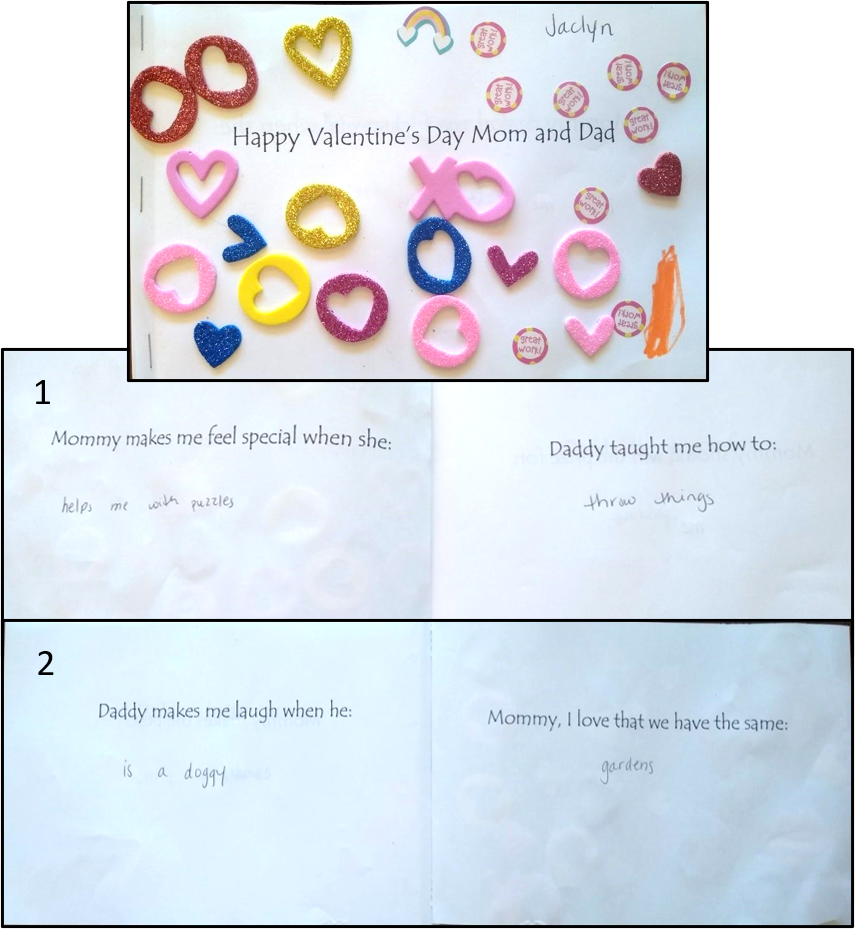
Figure 1: Jaclyn’s Valentine’s Day book for her mother and father: Cover; p. 1, “Mommy makes me feel special when she helps me with my puzzles. Daddy taught me how to throw things.”; p. 2, “Daddy makes me laugh when he is a doggy. Mommy, I love that we have the same gardens.”
“Writing” Favorite Things Through Art
After completing the Valentine’s Day books, I focused on children generating their own stories through art. To do this I invited children to illustrate the favorite things they’d been sharing. I met with each child individually to talk about their personal favorite things and then encouraged them to illustrate their stories about them. As they drew, I transcribed what they said so that I could remember and share with their parents and my peers.
After making her Valentine’s Day book (see Figure 1), Jaclyn, age 3, was excited to create a story about some of her favorite things (see Figure 2). While drawing she said, “My favorite color is pretty pink. My favorite thing is Mom and princesses,” and colored pink and drew her mom (right) and the princess (left) in green. As she continued telling her story she colored over both figures with blue, explaining, “The princess’s name is Ariel. Ariel is a mermaid.” That’s where her story ended and she went back to play.
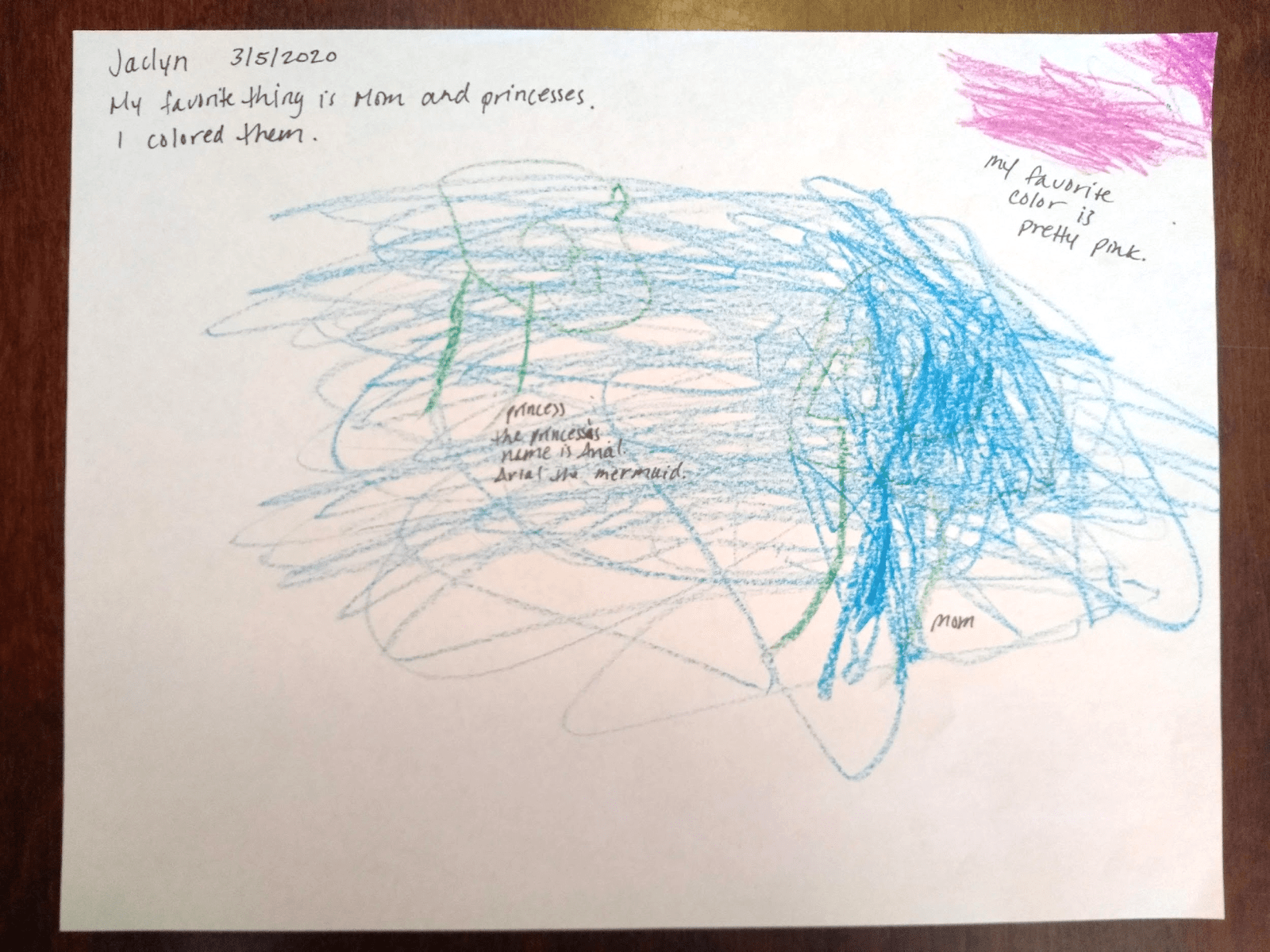
Figure 2: Jaclyn’s picture and story about her favorite color pretty pink, her mom (green figure on the right), and the princess mermaid Ariel (green figure on the left).
Haydynn, age 4, really liked Ed Emberley’s book Go Away, Big Green Monster (1992). As she drew, she told her story (see Figure 3) saying, “My favorite thing is monsters! He is green. He is saying ‘GAR’!”
I was particularly proud of Matthew, age 4. Matthew wanted his story to be about a lion (see Figure 4). At first, he asked me to draw everything for his story and said he couldn’t do it. I encouraged him and asked him what he wanted to draw. As he told me, I supported him by asking questions and suggesting how/what he might draw. For example, I asked, “What do eyes look like?” When he replied, “Two circles,” I said, “OK, draw two circles.” I asked, “What does a lion’s mane look like?” He said, “Lots of hair,” and I responded, “Draw lines around his head like a sun.” I encouraged him by saying things like, “Look, you’re doing it!” Matthew ended up illustrating his whole story and even elaborating the story completely on his own. He added the fireman, gave him an orange hat, and drew a lion scaring the fireman! His story was, “I like lions. He’s scaring a fireman. He has an orange hat.” It was truly exciting to witness that moment when Matthew realized he had a new skill and his own voice to tell his story.
Blaise, age 2, also had a story to tell. I really enjoyed how Blaise continued to elaborate on his story (see Figure 5). He began by stating that his favorite color was orange. With an orange crayon he continued to draw, telling his story as “a guy with a stick, a crown, and three ‘mouses’ [mice]”. He also added blue. I particularly liked that as he made dots, he called them out. This reminded me of The Dot (Reynolds, 2003) which we read early in the year.
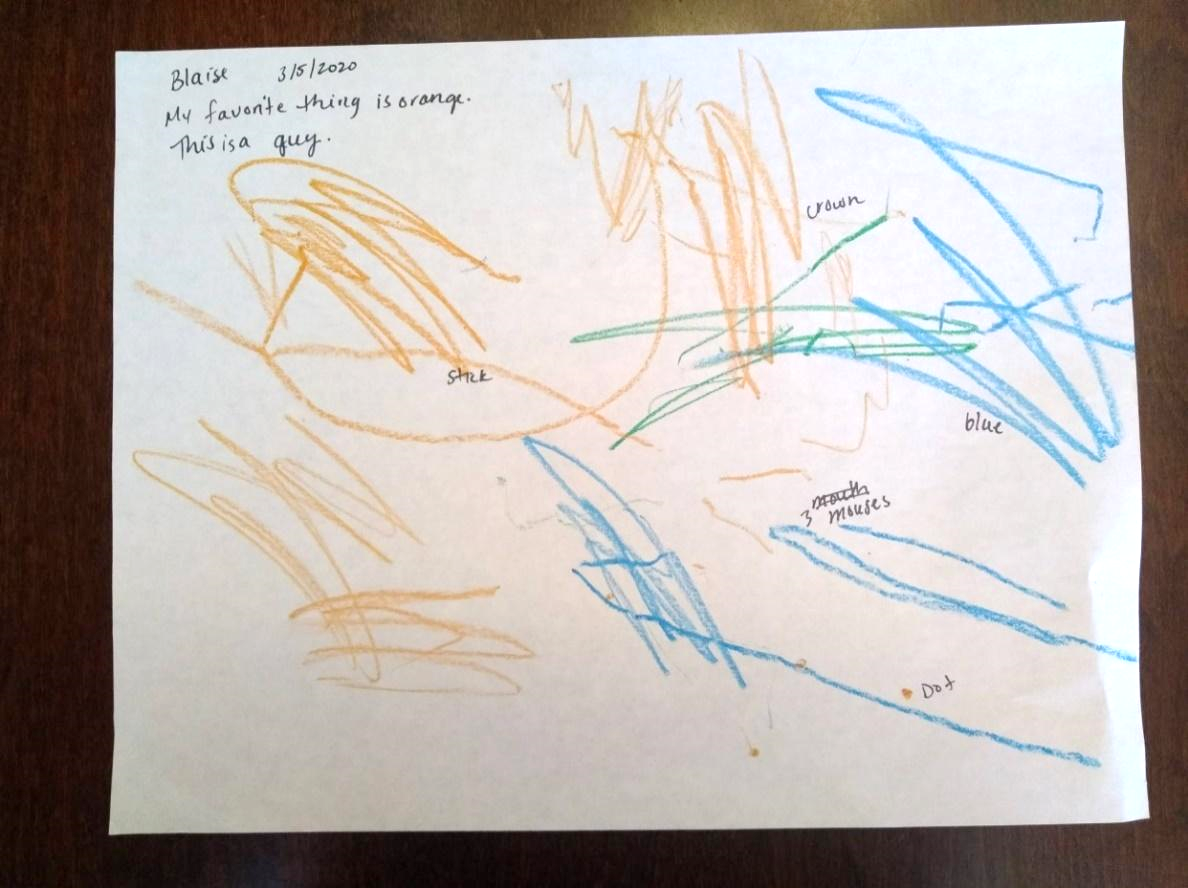
Figure 5: Blaise’s story: “My favorite thing is orange. This is a guy.” Clockwise, in orange he drew a stick and a crown and in blue three mice and a dot.
Lia-May, age 4, explained that her favorite thing was playing. She was very descriptive in her story and added details. She not only drew herself playing but she drew herself playing with a toy, her iPad (see Figure 6.). She said, “My favorite is playing. I’m playing with my iPad.”
I believe that by writing their stories through art these young children grew in several ways. One is they learned to sit and focus and begin to develop stamina as they created on a blank piece of paper. All of the children, particularly Blaise, Lia-May, and Haydynn, continued to add details and elaborate on their stories as they sat, focused, and worked. It was exciting to see their thinking and imaginations appear on paper. Children also began to confidently see themselves as writers and storytellers. Their growing confidence emerged as they excitedly talked and worked. This is true especially for Matthew and Jaclyn, whose story particularly contrasts with her Valentine’s Day book. Finally, I believe children learned they have a voice and stories to tell and that their stories are valuable. By sitting with them, listening to their stories, asking them questions, and encouraging them, children saw their stories are important and matter to others.
Closing Reflections
I started the school year with no teaching background and have learned a lot. For example, I learned that children learn about people, places, and things through global literature, conversations about them, and play associated with the ideas in books. Global literature is more than simple stories about people like themselves: it introduces them to a variety of places and cultures. Through global literature children “meet” new people and have new “experiences” that open their minds and understandings about themselves, others, and the world (Acevedo et al., 2017; Corapi and Short, 2015). Discussing the literature, characters and events, and relating those to the children helped them connect to the books and think about their own stories. I also learned that young children can and do tell their own stories through art (Ray, 2010). Drawing and illustration is an easy way for them to start writing books. Asking children to tell me their stories valued their voices and helped me learn more about them. In only a year of school, children grew significantly in their art, drawing, conversation, and storytelling abilities.
As a teacher, I learned most importantly that if I sit back and let children take the lead in their own learning experiences, they will engage each other, as well as the teachers, in learning more than I ever thought I could teach.
References
Acevedo, M., Pangle, L., Kleker, D., & Short, K. (2017). Engaging young children with global literature. The Dragon Lode, 35(2), 17-26.
Corapi, S., & Short, K. G. (2015). Exploring international and intercultural understanding through global literature. Research Report, Web publication, Longview Foundation. http://wowlit.org/Documents/InterculturalUnderstanding.pdf
Ray, K.W. (2010). In pictures and in words: Teaching the qualities of good writing through illustration study. Portsmouth, NH: Heinemann.
Children’s Literature Cited
Benjamin, C.. & Rogers, J. (1999). Footprints in the Sand. New York: Scholastic.
Emberley, E. (1992). Go Away, Big Green Monster. New York: Little, Brown.
Könnecke, O. (2015). You Can Do It, Bert. Minneapolis, MN: Gecko Press/Lerner Publishing.
National Geographic Society. (1987). Creatures of the Desert World. Washington, D.C.: National Geographic Society.
Cassandra Sutherland teaches at Creation School, most recently in Preschool classrooms.
© 2020 by Cassandra Sutherland
WOW Stories, Volume VIII, Issue 1 by Worlds of Words is licensed under a Creative Commons Attribution-NonCommercial-ShareAlike 4.0 International License.
Based on a work by Cassandra Sutherland at https://wowlit.org/on-line-publications/stories/volume-viii-issue-1/6/.
WOW stories: connections from the classroom
ISSN 2577-0551

